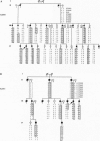Abstract
Cerebral cavernous malformation is a common disease of the brain vasculature of unknown cause characterized by dilated thin-walled sinusoidal vessels (caverns); these lesions cause varying clinical presentations which include headache, seizure, and hemorrhagic stroke. This disorder is frequently familial, with autosomal dominant inheritance. Using a general linkage approach in two extended cavernous malformation kindreds, we have identified linkage of this trait to chromosome 7q11.2-q21. Multipoint linkage analysis yields a peak logarithm of odds (lod) score of 6.88 with zero recombination with locus D7S669 and localizes the gene to a 7-cM region in the interval between loci ELN and D7S802.
Full text
PDF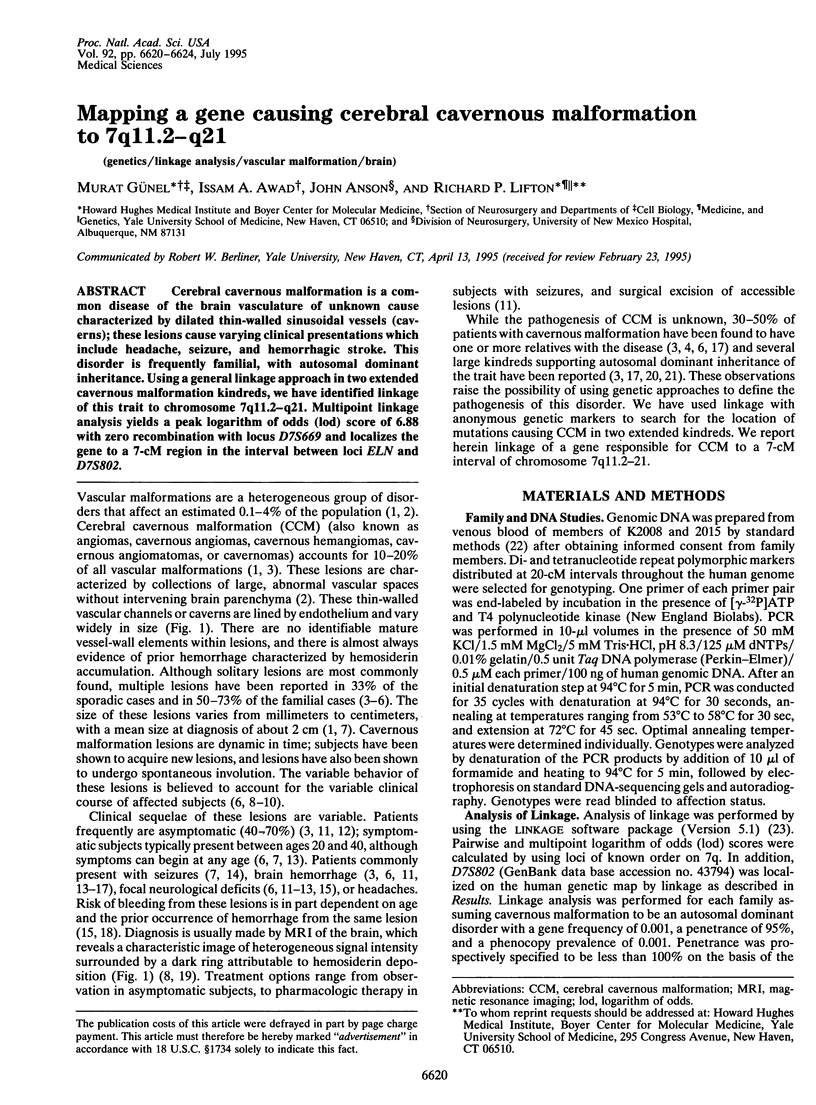
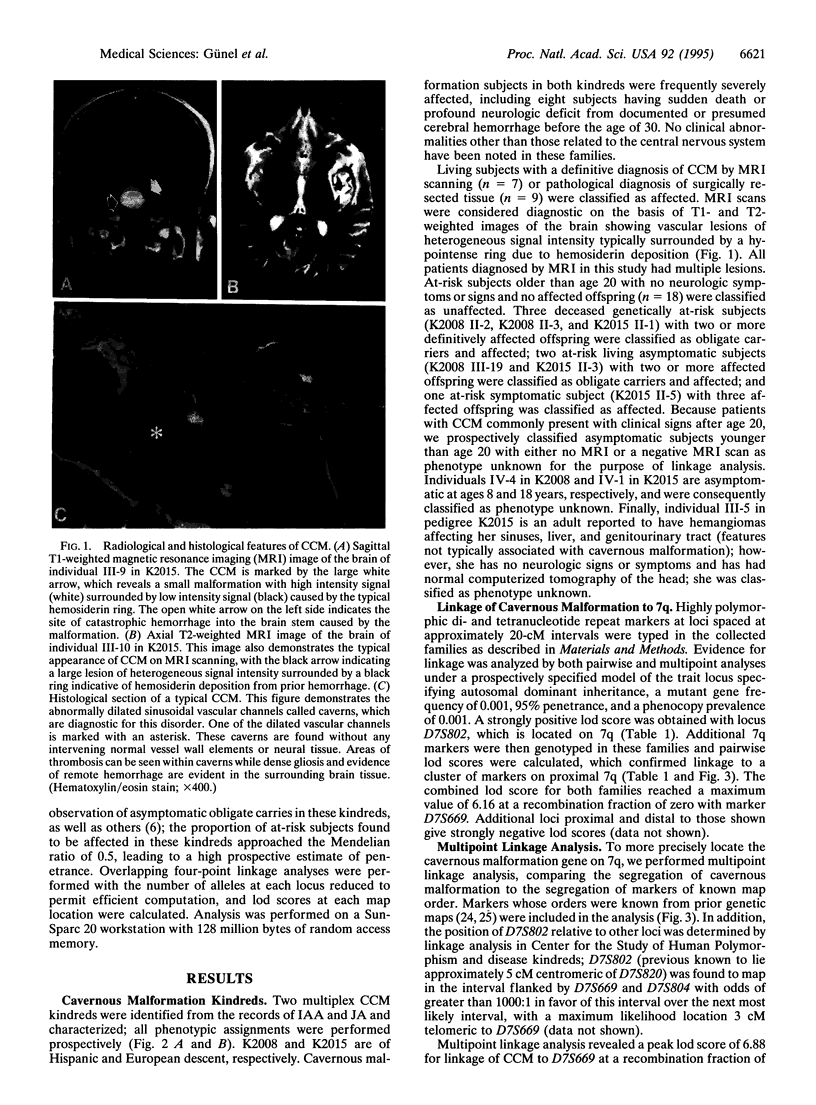
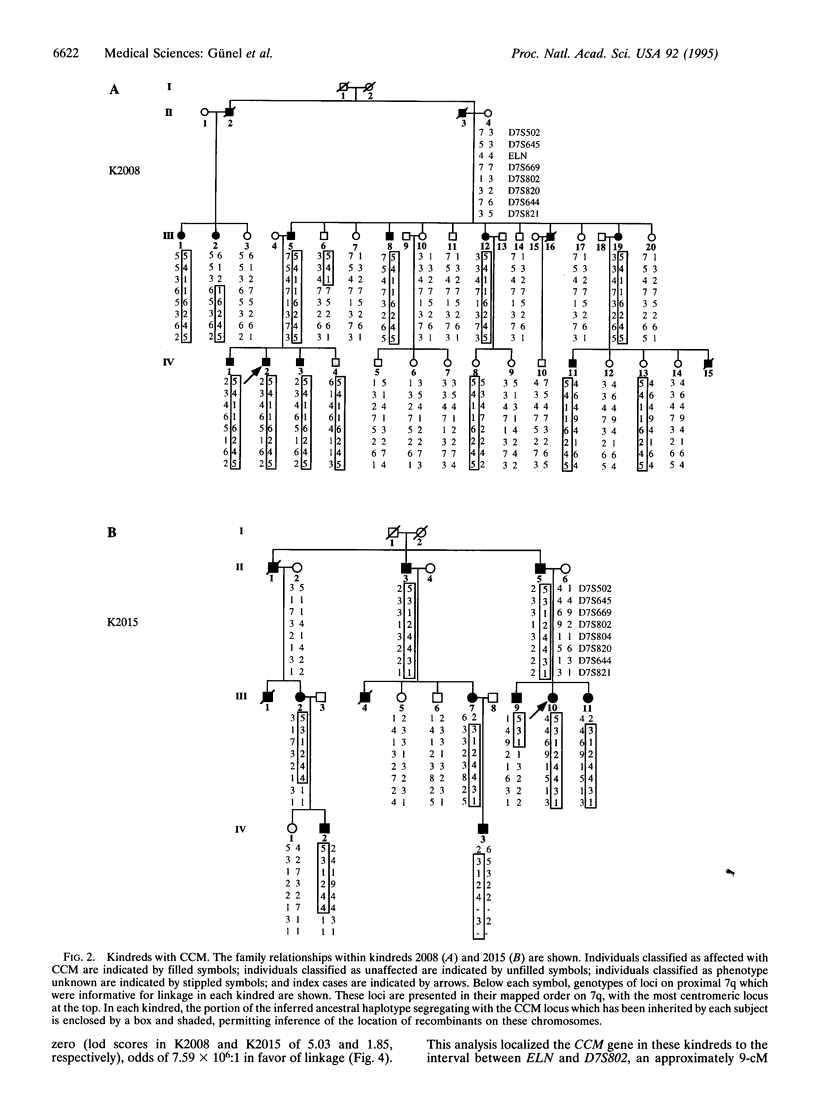
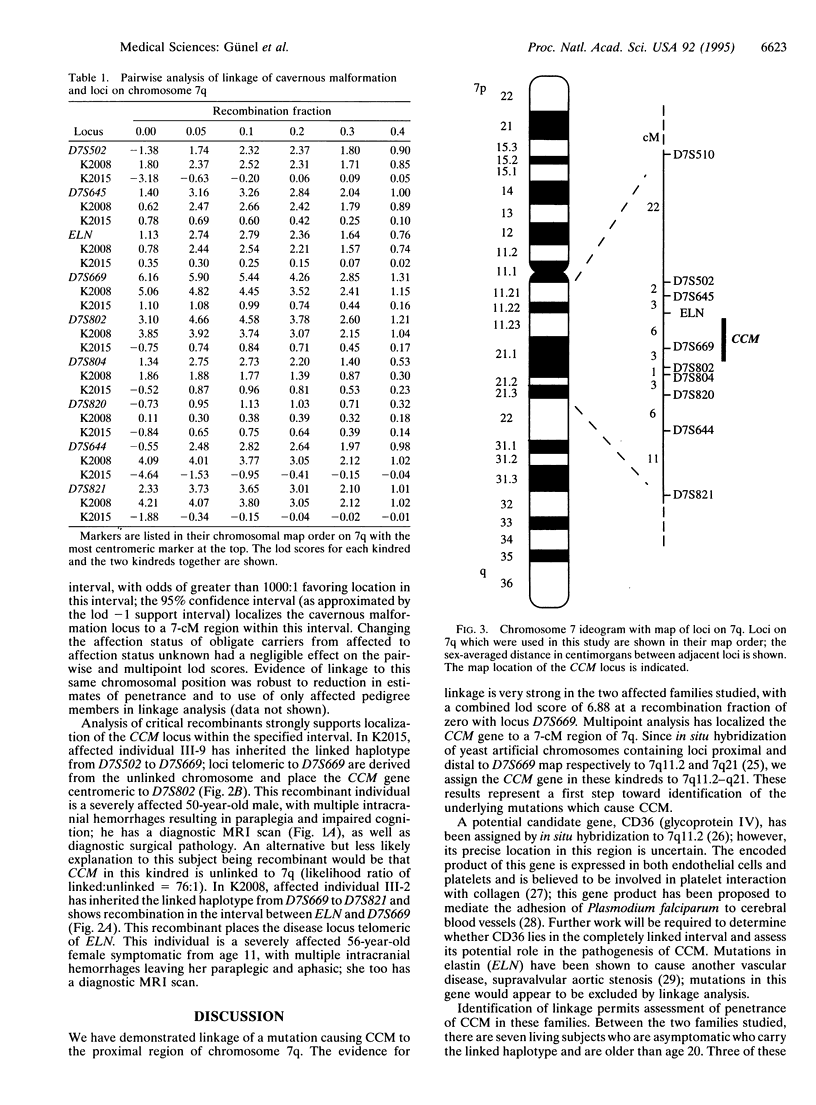
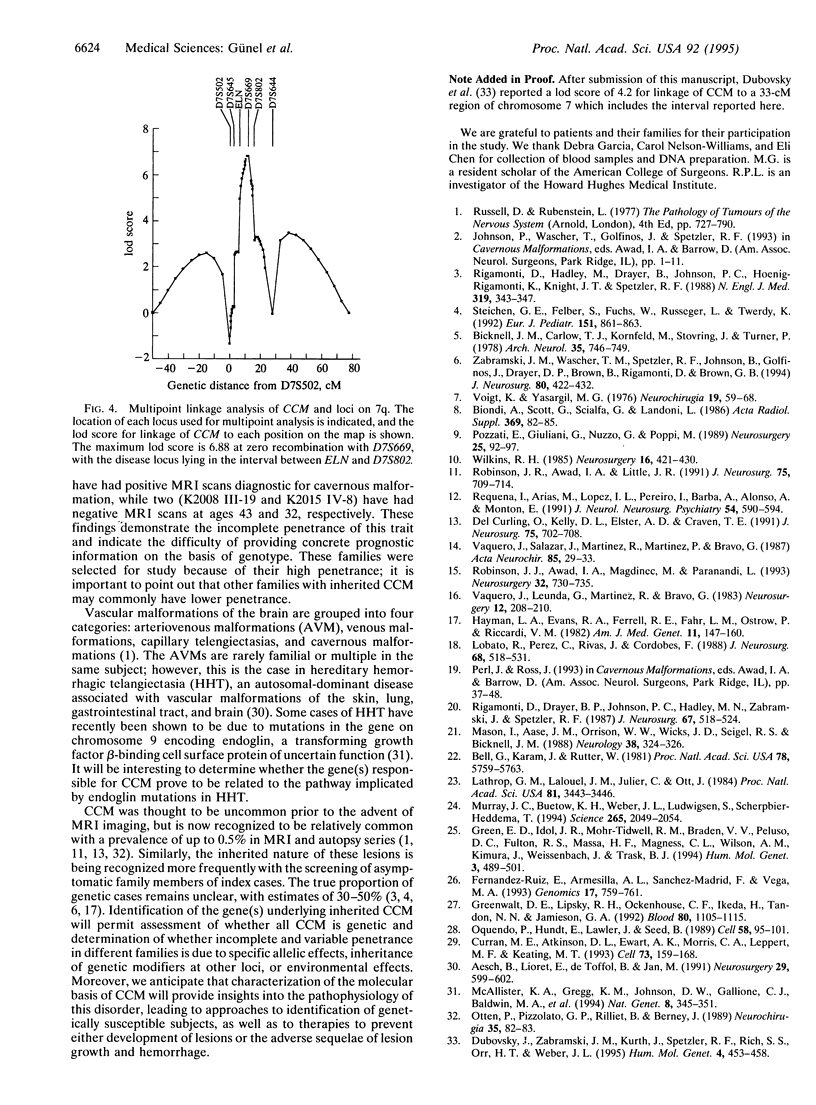
Images in this article
Selected References
These references are in PubMed. This may not be the complete list of references from this article.
- Aesch B., Lioret E., de Toffol B., Jan M. Multiple cerebral angiomas and Rendu-Osler-Weber disease: case report. Neurosurgery. 1991 Oct;29(4):599–602. doi: 10.1097/00006123-199110000-00020. [DOI] [PubMed] [Google Scholar]
- Bell G. I., Karam J. H., Rutter W. J. Polymorphic DNA region adjacent to the 5' end of the human insulin gene. Proc Natl Acad Sci U S A. 1981 Sep;78(9):5759–5763. doi: 10.1073/pnas.78.9.5759. [DOI] [PMC free article] [PubMed] [Google Scholar]
- Bicknell J. M., Carlow T. J., Kornfeld M., Stovring J., Turner P. Familial cavernous angiomas. Arch Neurol. 1978 Nov;35(11):746–749. doi: 10.1001/archneur.1978.00500350050010. [DOI] [PubMed] [Google Scholar]
- Biondi A., Scotti G., Scialfa G., Landoni L. Magnetic resonance imaging of cerebral cavernous angiomas. Acta Radiol Suppl. 1986;369:82–85. [PubMed] [Google Scholar]
- Curran M. E., Atkinson D. L., Ewart A. K., Morris C. A., Leppert M. F., Keating M. T. The elastin gene is disrupted by a translocation associated with supravalvular aortic stenosis. Cell. 1993 Apr 9;73(1):159–168. doi: 10.1016/0092-8674(93)90168-p. [DOI] [PubMed] [Google Scholar]
- Del Curling O., Jr, Kelly D. L., Jr, Elster A. D., Craven T. E. An analysis of the natural history of cavernous angiomas. J Neurosurg. 1991 Nov;75(5):702–708. doi: 10.3171/jns.1991.75.5.0702. [DOI] [PubMed] [Google Scholar]
- Dubovsky J., Zabramski J. M., Kurth J., Spetzler R. F., Rich S. S., Orr H. T., Weber J. L. A gene responsible for cavernous malformations of the brain maps to chromosome 7q. Hum Mol Genet. 1995 Mar;4(3):453–458. doi: 10.1093/hmg/4.3.453. [DOI] [PubMed] [Google Scholar]
- Fernández-Ruiz E., Armesilla A. L., Sánchez-Madrid F., Vega M. A. Gene encoding the collagen type I and thrombospondin receptor CD36 is located on chromosome 7q11.2. Genomics. 1993 Sep;17(3):759–761. doi: 10.1006/geno.1993.1401. [DOI] [PubMed] [Google Scholar]
- Green E. D., Idol J. R., Mohr-Tidwell R. M., Braden V. V., Peluso D. C., Fulton R. S., Massa H. F., Magness C. L., Wilson A. M., Kimura J. Integration of physical, genetic and cytogenetic maps of human chromosome 7: isolation and analysis of yeast artificial chromosome clones for 117 mapped genetic markers. Hum Mol Genet. 1994 Mar;3(3):489–501. doi: 10.1093/hmg/3.3.489. [DOI] [PubMed] [Google Scholar]
- Greenwalt D. E., Lipsky R. H., Ockenhouse C. F., Ikeda H., Tandon N. N., Jamieson G. A. Membrane glycoprotein CD36: a review of its roles in adherence, signal transduction, and transfusion medicine. Blood. 1992 Sep 1;80(5):1105–1115. [PubMed] [Google Scholar]
- Hayman L. A., Evans R. A., Ferrell R. E., Fahr L. M., Ostrow P., Riccardi V. M. Familial cavernous angiomas: natural history and genetic study over a 5-year period. Am J Med Genet. 1982 Feb;11(2):147–160. doi: 10.1002/ajmg.1320110205. [DOI] [PubMed] [Google Scholar]
- Lathrop G. M., Lalouel J. M., Julier C., Ott J. Strategies for multilocus linkage analysis in humans. Proc Natl Acad Sci U S A. 1984 Jun;81(11):3443–3446. doi: 10.1073/pnas.81.11.3443. [DOI] [PMC free article] [PubMed] [Google Scholar]
- Lobato R. D., Perez C., Rivas J. J., Cordobes F. Clinical, radiological, and pathological spectrum of angiographically occult intracranial vascular malformations. Analysis of 21 cases and review of the literature. J Neurosurg. 1988 Apr;68(4):518–531. doi: 10.3171/jns.1988.68.4.0518. [DOI] [PubMed] [Google Scholar]
- Mason I., Aase J. M., Orrison W. W., Wicks J. D., Seigel R. S., Bicknell J. M. Familial cavernous angiomas of the brain in an Hispanic family. Neurology. 1988 Feb;38(2):324–326. doi: 10.1212/wnl.38.2.324. [DOI] [PubMed] [Google Scholar]
- McAllister K. A., Grogg K. M., Johnson D. W., Gallione C. J., Baldwin M. A., Jackson C. E., Helmbold E. A., Markel D. S., McKinnon W. C., Murrell J. Endoglin, a TGF-beta binding protein of endothelial cells, is the gene for hereditary haemorrhagic telangiectasia type 1. Nat Genet. 1994 Dec;8(4):345–351. doi: 10.1038/ng1294-345. [DOI] [PubMed] [Google Scholar]
- Murray J. C., Buetow K. H., Weber J. L., Ludwigsen S., Scherpbier-Heddema T., Manion F., Quillen J., Sheffield V. C., Sunden S., Duyk G. M. A comprehensive human linkage map with centimorgan density. Cooperative Human Linkage Center (CHLC). Science. 1994 Sep 30;265(5181):2049–2054. doi: 10.1126/science.8091227. [DOI] [PubMed] [Google Scholar]
- Oquendo P., Hundt E., Lawler J., Seed B. CD36 directly mediates cytoadherence of Plasmodium falciparum parasitized erythrocytes. Cell. 1989 Jul 14;58(1):95–101. doi: 10.1016/0092-8674(89)90406-6. [DOI] [PubMed] [Google Scholar]
- Otten P., Pizzolato G. P., Rilliet B., Berney J. A propos de 131 cas d'angiomes caverneux (cavernomes) du s.n.c., repérés par l'analyse rétrospective de 24 535 autopsies. Neurochirurgie. 1989;35(2):82-3, 128-31. [PubMed] [Google Scholar]
- Pozzati E., Giuliani G., Nuzzo G., Poppi M. The growth of cerebral cavernous angiomas. Neurosurgery. 1989 Jul;25(1):92–97. doi: 10.1097/00006123-198907000-00017. [DOI] [PubMed] [Google Scholar]
- Requena I., Arias M., López-Ibor L., Pereiro I., Barba A., Alonso A., Montón E. Cavernomas of the central nervous system: clinical and neuroimaging manifestations in 47 patients. J Neurol Neurosurg Psychiatry. 1991 Jul;54(7):590–594. doi: 10.1136/jnnp.54.7.590. [DOI] [PMC free article] [PubMed] [Google Scholar]
- Rigamonti D., Drayer B. P., Johnson P. C., Hadley M. N., Zabramski J., Spetzler R. F. The MRI appearance of cavernous malformations (angiomas). J Neurosurg. 1987 Oct;67(4):518–524. doi: 10.3171/jns.1987.67.4.0518. [DOI] [PubMed] [Google Scholar]
- Rigamonti D., Hadley M. N., Drayer B. P., Johnson P. C., Hoenig-Rigamonti K., Knight J. T., Spetzler R. F. Cerebral cavernous malformations. Incidence and familial occurrence. N Engl J Med. 1988 Aug 11;319(6):343–347. doi: 10.1056/NEJM198808113190605. [DOI] [PubMed] [Google Scholar]
- Robinson J. R., Awad I. A., Little J. R. Natural history of the cavernous angioma. J Neurosurg. 1991 Nov;75(5):709–714. doi: 10.3171/jns.1991.75.5.0709. [DOI] [PubMed] [Google Scholar]
- Robinson J. R., Jr, Awad I. A., Magdinec M., Paranandi L. Factors predisposing to clinical disability in patients with cavernous malformations of the brain. Neurosurgery. 1993 May;32(5):730–736. doi: 10.1227/00006123-199305000-00005. [DOI] [PubMed] [Google Scholar]
- Steichen-Gersdorf E., Felber S., Fuchs W., Russeger L., Twerdy K. Familial cavernous angiomas of the brain: observations in a four generation family. Eur J Pediatr. 1992 Nov;151(11):861–863. doi: 10.1007/BF01957941. [DOI] [PubMed] [Google Scholar]
- Vaquero J., Leunda G., Martínez R., Bravo G. Cavernomas of the brain. Neurosurgery. 1983 Feb;12(2):208–210. doi: 10.1227/00006123-198302000-00013. [DOI] [PubMed] [Google Scholar]
- Vaquero J., Salazar J., Martínez R., Martínez P., Bravo G. Cavernomas of the central nervous system: clinical syndromes, CT scan diagnosis, and prognosis after surgical treatment in 25 cases. Acta Neurochir (Wien) 1987;85(1-2):29–33. doi: 10.1007/BF01402366. [DOI] [PubMed] [Google Scholar]
- Voigt K., Yaşargil M. G. Cerebral cavernous haemangiomas or cavernomas. Incidence, pathology, localization, diagnosis, clinical features and treatment. Review of the literature and report of an unusual case. Neurochirurgia (Stuttg) 1976 Mar;19(2):59–68. doi: 10.1055/s-0028-1090391. [DOI] [PubMed] [Google Scholar]
- Wilkins R. H. Natural history of intracranial vascular malformations: a review. Neurosurgery. 1985 Mar;16(3):421–430. doi: 10.1227/00006123-198503000-00026. [DOI] [PubMed] [Google Scholar]
- Zabramski J. M., Wascher T. M., Spetzler R. F., Johnson B., Golfinos J., Drayer B. P., Brown B., Rigamonti D., Brown G. The natural history of familial cavernous malformations: results of an ongoing study. J Neurosurg. 1994 Mar;80(3):422–432. doi: 10.3171/jns.1994.80.3.0422. [DOI] [PubMed] [Google Scholar]




